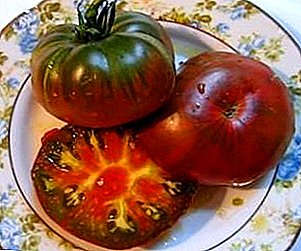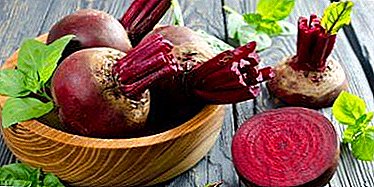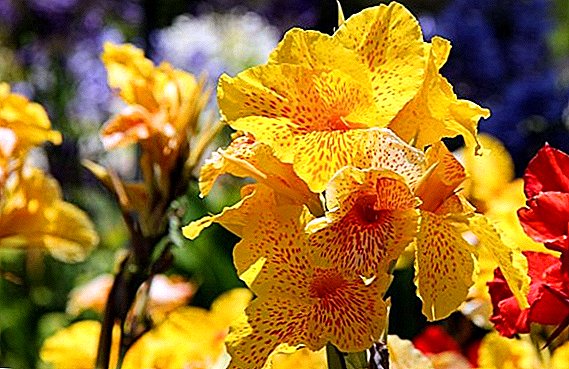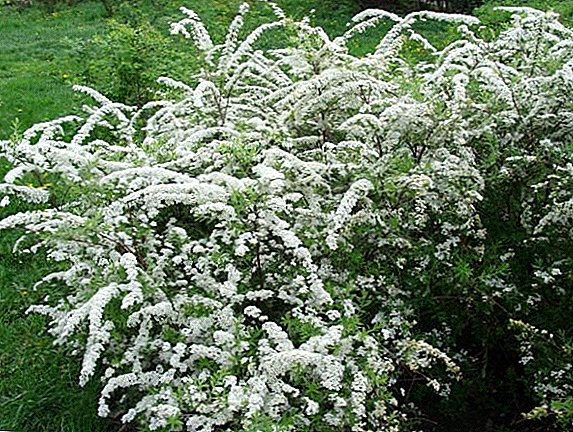 If you want to improve your site with vegetation, pay attention to a wonderful shrub called Argut spirea. Among the many similar forms of plants in your garden, she will stand out with special elegance and beauty, of course, if you provide her with full care for harmonious growth and development. What you need to know about the rules of growing handsome, and how to organize care for her - read on.
If you want to improve your site with vegetation, pay attention to a wonderful shrub called Argut spirea. Among the many similar forms of plants in your garden, she will stand out with special elegance and beauty, of course, if you provide her with full care for harmonious growth and development. What you need to know about the rules of growing handsome, and how to organize care for her - read on.
Botanical description
This article focuses on unpretentious winter-hardy deciduous shrub belonging to the family of pink. Argut spirea is a hybrid form, the "parents" of which are Thunberg spirea and a multi-flowered variety. It can reach a height of two meters in height, and is often spread three meters wide. Four-centimeter leaves of spirea - dark green, narrow, lanceolate and strongly serrated.  Branches - thin and curved in the form of an arc. The shrub is distinguished by its special decorative value due to its white flowers, reaching up to 0.8 cm in diameter. All of them are collected in umbrella inflorescences, which densely cover the entire bush. Flowering occurs from May to June, with flowers placed on last year's shoots.
Branches - thin and curved in the form of an arc. The shrub is distinguished by its special decorative value due to its white flowers, reaching up to 0.8 cm in diameter. All of them are collected in umbrella inflorescences, which densely cover the entire bush. Flowering occurs from May to June, with flowers placed on last year's shoots.
Did you know? Spiraea was the first source of aspirin known to all. As early as 1839, the glycoside salicin was discovered in its shoots, which, as a result of chemical transformations, has become a well-known drug.Spiraea argutta refers to slow-growing plants, with an annual increase of only 10-20 cm, but it tolerates pruning well.
Distribution and habitat
Given that the described shrub belongs to the hybrid forms of plants, it can be found rather near private estates and in parks, rather than in open areas. It is well acclimatized on fertile soils and is distinguished by a high level of frost resistance, due to which it can be grown in almost all regions (except the northernmost).
Familiarize yourself with the peculiarities of growing Japanese spirea, white spirea, Nippon spirea, Bumald spirea, willow spirea, Grefsham spirea, birch spirea, Wangutta spirea.
Use in landscape design
The botanical data of the Spirea Argut allow it to be used in landscape design, both in single and in group plantings. The plant is suitable for landscaping private, urban and even industrial sites, looks good in hedges, parks, gardens and mixed plantings, favorably standing out from the rest of the plants with its delicate white flowers.
Growing and caring for plants
Argut spirea is an unpretentious plant, but if you want it to take root well on your site and constantly delight you with its decorative effect, you will have to follow certain rules of planting and further care.
We recommend that you familiarize yourself with the varieties and varieties of spirea.
Conditions of detention
The first thing you should pay attention to before planting a bush is the place of its future growth. For argut spirea, an open solar area would be an ideal option, without close occurrence of groundwater. However, if you do not have a way out and you are forced to plant this beauty in the shade, then it will take root there, except that the flowering will not be so lush. As for the composition of the soil, it is better that it be fertile, but clayey soils and loams will also not become a big problem. To facilitate the adaptation process, a mixture of sod land, peat and sand can be poured into the landing pit, keeping the ratio 2: 1: 1. 
Soil and fertilizer
As we have already mentioned, Argut spiraea feels great on fertile soils, but this does not mean that you have to constantly feed it. In most cases, planting fertilizer will be enough for a plant for a year, or even more, and additional nutrients will be needed unless after cardinal pruning.
Did you know? Spirea from antiquity is widespread in Russian land, so it is not surprising that during the times of the existence of Russia, people found practical application for it. Of the long and thin rods often made ramrod and carrot.In the latter case, the plant removes all the shoots, and the bush begins to grow again (from the root), for which he will need strength. You can prepare the nutritional composition by mixing organic matter (compost 5–7 cm thick) and complex mineral fertilizers in the amount of 30 g of urea and 100 g of Kemira.
Read also about what kind of ornamental shrubs with white flowers can be planted in your garden.
Watering and moisture
The plant needs systematic, but moderate watering, especially when it comes to mulching soil. In hot and dry summer days, the application of liquid should be done once every three days, and in normal weather, with moderate precipitation - once every 7-8 days. Usually, about 15 liters of water per bush should be used in one irrigation, after which the soil is mulched so that it does not become covered with a crust. 
Relation to temperature
Argut spirea feels great in the hot summer months, but it will withstand the cold winter no less steadfastly. If you believe reviews of gardeners from the northern regions, then you should not be afraid of the shrub even in the forty-degree frost. He perezimuet well without any shelter.
Plant reproduction and planting
Being a hybrid plant, Argut spirea is unable to reproduce by the seed method, but it is very well suited for grafting and cultivation by layering. 10-centimeter cuttings are cut from the semi-lignified shoots of the current year and are placed for 12 hours in a solution of humic fertilizer or a parstimulating composition. After the specified time, they are placed in prepared pits, deepening 3-4 cm into the soil.
Also layering can propagate lilac, ivy, hydrangea and dracaena.
If you perform this procedure in the middle of summer, then by the fall there will be good roots. If possible, you can use green cuttings that are cut at the beginning of summer. The length of such segments should be 7-10 cm, and it is good if there are distant lower leaves on them. In this case, the planting depth will correspond to 2 cm. In order to reproduce by layering when leaves appear (this usually happens at the end of spring), it is necessary to bend to the soil the branches along the edges of the bush, and put them in organized trenches and sprinkle them with soil.  So that they grow up, they are tied to pegs, thereby directing in the right direction, after which they are watered and fertilized once every 7 days with organic matter. With the right care for the next spring there is every chance of getting decent seedlings, with a well-developed root system.
So that they grow up, they are tied to pegs, thereby directing in the right direction, after which they are watered and fertilized once every 7 days with organic matter. With the right care for the next spring there is every chance of getting decent seedlings, with a well-developed root system.
Important! For faster development of rhizomes, the first inflorescences that appear on young bushes, it is better to immediately remove.The most suitable time for planting Argut spirea seedlings is the first half of April. The pit should be prepared in advance by digging a small trench, 0.5 m deep and 30% larger than an earthen seedling. To begin with, a drainage layer prepared from a mixture of pebbles, rubble and expanded clay (approximate thickness - 10 cm) is placed on the bottom, and a 5-centimeter layer of sand is placed on top of it.

The landing process itself is as follows:
- Taking the seedling at the base with one hand, lower it into the pit so that the root neck is flush with the soil surface.
- With your second hand, gently fill the pit with a mixture of soil and fertilizer, carefully making sure that all the roots are well straightened and not directed upwards.
- Having filled up the rhizome, pour the seedling and sprinkle some more earth, and after 30 minutes pour the soil with liquid humic fertilizer.
- It is useful to soil the soil surface with a peat layer 5-7 cm thick.
Pruning
Argut spirea blooms in spring and practically does not need pruning. The only exception would be the sanitary measures that take place immediately after the flowering of the shrub. To be removed dried, damaged branches and old shoots that are more than five years old. It is not worth to shorten the faded shoots, as this will only strengthen the growth of side branches and there will be no effect of the falling “hair”.  Spirea pruning. Argut spirea is formed at the end of March or at the beginning of April by removing frozen and weak branches. Only 5-6 strongest shoots are left. In order to fully rejuvenate the bush, you will have to remove all the old branches at the root, so that dormant buds awaken and go to growth.
Spirea pruning. Argut spirea is formed at the end of March or at the beginning of April by removing frozen and weak branches. Only 5-6 strongest shoots are left. In order to fully rejuvenate the bush, you will have to remove all the old branches at the root, so that dormant buds awaken and go to growth.
Important! In order for Argut's spirea to retain its decorative properties, it needs a lightening haircut (pruning of long-flowering shoots), which is performed every 2-3 years.
Possible difficulties in growing
With a responsible approach to the issue of growing plants, there should be no difficulties. However, there are several nuances that are still worth remembering:
- The argut spirea planted in the fall may simply not survive the winter, even despite its high winter hardiness. Young plants are not as strong as fully formed, so it is desirable to provide them with the most comfortable conditions for growth and development;
- Pruning shrubs deserves special attention, because if you cut off the flowering shoots, this will lead to increased growth of the side branches, with small flowers at the end (the overall decorative appearance of the shrub will suffer). Otherwise, this type of spirea is unlikely to cause you trouble.

Important! Despite the high winter hardiness of the spirea, it is still advisable for the residents of the northern regions to shelter the plant for the winter, because if it froze a little, the overall decorative look will definitely suffer.
Pests, diseases and prevention
Argut spiraeus is deservedly considered a hardy plant, because the habitual shrub ills are almost not afraid of it. For the most part, it suffers from pests, among which are spider mites, aphids, rosaceous leafworm, rosaceous miner and various caterpillars:
- The spider mite gnaws holes on the leaves and inflorescences and leaves the spider webs on the shoots. The leaves turn yellow, dry and fall prematurely, and insects are especially active in hot and dry summers. To get rid of pests and return the plant all its decorativeness, it is necessary to process the spiraea shoots with a 0.2% solution of Phosphamide, Acrex, Keltan or Karbofos.
- Aphids mainly affect the leaves and young inflorescences, while organizing in whole colonies of harmful insects. She drinks all the juice from spirea, starting its activity from the end of June and continuing to rage until August. For the treatment of the affected plant, at the beginning of the growing season, apply a granular composition of 5% "Pyrimor", which is applied to the soil, deepening by 2-5 cm (15 g of substance per square meter of territory).
- Rosan leafworm is activated at an average temperature of +13 ° C. The pest caterpillars pull a few leaves into a tube and gnaw holes through them, causing the bush to dry and lose its decorative effect. For the treatment of the plant, use a 0.7% mixture of Bitoxibacillin mixed with 0.03% Pyrimor.
Familiarize yourself with how to deal with spider mites and leafworms.These insecticides can also be used when other pests appear, therefore they will never be superfluous. If you want to protect argut spirea from any such danger, then it is better to plant seedlings away from a possible source of infection and to fertilize plants in a timely manner. As for diseases, spirea can suffer from such infectious ailments as gray mold and various types of spotting, but this is extremely rare.
 The drug "Fitosporin". For the treatment of these misfortunes, fungicidal preparations like Fundazole, Fitosporin, Bordeaux mixture and colloidal sulfur are used. Provide proper care and attention to spirea argut - and the shrub will always delight you with its beauty and elegance, becoming an excellent element of landscape design.
The drug "Fitosporin". For the treatment of these misfortunes, fungicidal preparations like Fundazole, Fitosporin, Bordeaux mixture and colloidal sulfur are used. Provide proper care and attention to spirea argut - and the shrub will always delight you with its beauty and elegance, becoming an excellent element of landscape design.











